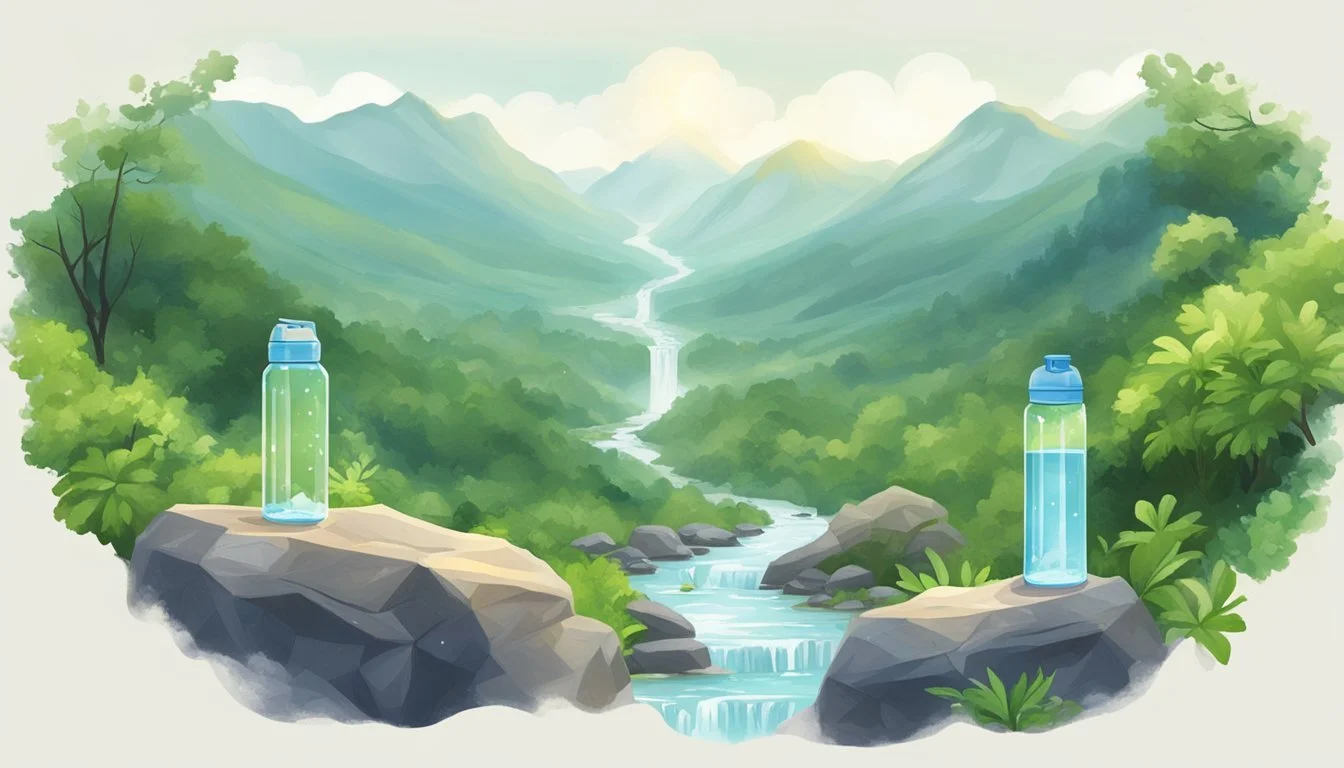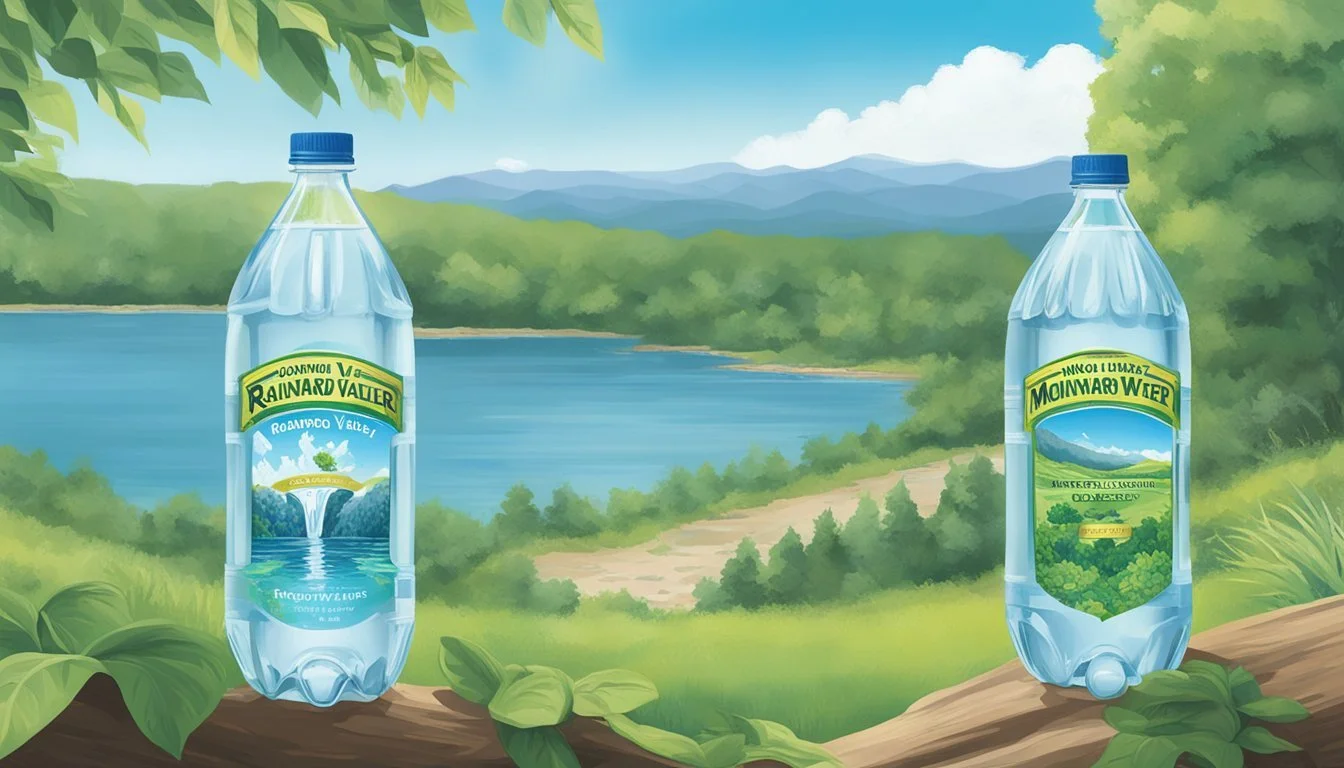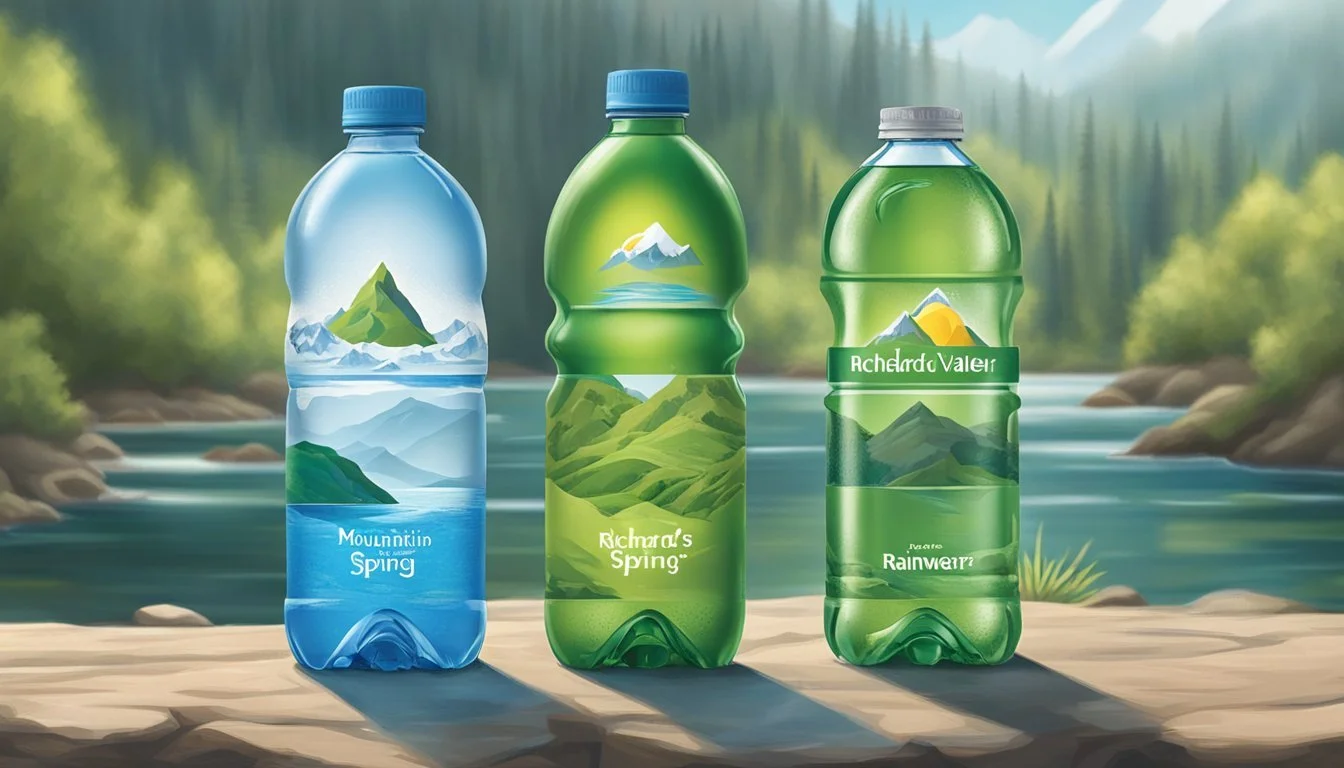Mountain Valley Spring Water vs. Richard’s Rainwater
Which is Superior?
When choosing between Mountain Valley Spring Water and Richard’s Rainwater, it's essential to compare their unique qualities. Both brands offer high-quality, clean drinking water, but their sources and characteristics set them apart. Mountain Valley Spring Water, sourced from the Ouachita Mountains in Arkansas since 1871, is known for its balanced pH and rich mineral content.
Richard’s Rainwater presents a different approach, collecting rainwater and purifying it directly. This method ensures remarkable purity, free from elements typically found in groundwater. The freshness and eco-friendly focus of Richard's Rainwater appeal to environmentally conscious consumers.
Ultimately, the decision might hinge on personal preference between the mineral-rich profile of Mountain Valley Spring Water and the pure, natural taste of Richard’s Rainwater. Understanding these differences can guide you to the best choice for your hydration needs.
The Basics of Bottled Water
Bottled water is a widely consumed product, comprising several types, such as spring water and rainwater. Each type has its unique characteristics and is subject to various regulations to ensure safety and quality.
Understanding Bottled Water
Bottled water is water packaged in plastic or glass bottles and intended for human consumption. It can be sourced from different places like springs, wells, or even rainwater collection systems. Each source type imparts specific qualities to the water, making it unique in taste and composition.
The FDA regulates bottled water in the United States, ensuring that it meets safety standards similar to those for tap water. Bottled water is classified broadly into mineral water, spring water, purified water, and rainwater, among others. Each classification has specific characteristics defined by its source and treatment process, which affects its taste, mineral content, and overall profile.
Comparing Spring Water and Rainwater
Spring water is typically sourced from underground springs that flow naturally to the earth’s surface. This type of water often boasts a distinct mineral profile, which can influence its taste. Mountain Valley Spring Water, for example, is celebrated for its pure, crisp taste and rich mineral content.
Rainwater is collected directly from the sky, usually through carefully managed collection systems that ensure minimal contamination. Richard’s Rainwater is known for its sustainability and neutral taste. Unlike spring water, rainwater generally lacks the mineral content and distinct taste because it is often purified after collection.
Comparing the two, spring water often contains more total dissolved solids (TDS), giving it a richer taste profile, while rainwater appeals to those who prefer a cleaner, more neutral flavor.
Regulation and Quality Standards
The quality and safety of bottled water are regulated primarily by the FDA. These regulations encompass everything from water source protection, bottling processes, and labeling requirements. FDA standards ensure bottled water is free from pathogens and harmful chemicals.
Besides FDA regulations, many brands also adhere to additional quality benchmarks such as the Berkeley Springs International Water Tasting standards, which assess taste and overall quality. Mountain Valley Spring Water, for example, has received numerous accolades for its exceptional quality and flavor.
In sum, bottled water undergoes rigorous regulation to ensure safety. Brands that meet and exceed these standards, like Mountain Valley and Richard’s Rainwater, offer consumers reliable and often exceptional products.
Mountain Valley Spring Water
Mountain Valley Spring Water is celebrated for its crisp, refreshing taste and attention to sustainability. This section explores its source and filtration process, mineral content and taste, and packaging and sustainability efforts.
Source and Filtration
Mountain Valley Spring Water originates from a natural spring in the Ouachita Mountains of Arkansas. The spring is known for its naturally occurring purity, eliminating the need for extensive treatment.
The water undergoes minimal filtration to preserve its natural minerals. This gentle process ensures that consumers receive water that is as close to its natural state as possible, highlighting the brand’s commitment to authenticity.
Mineral Content and Taste
Mountain Valley Spring Water is prized for its balanced mineral content, which includes naturally occurring calcium, magnesium, and potassium. These minerals contribute to its uniquely smooth and refreshing taste.
The water's flavor profile is often described as crisp and clean with a wonderfully rounded taste, making it a favorite among water enthusiasts. This balanced composition has led Mountain Valley to receive numerous awards for taste and quality.
Packaging and Sustainability
Mountain Valley places a significant emphasis on sustainability. Their use of glass bottles is both eco-friendly and helps to maintain the water's pure taste without the risk of leaching chemicals, often associated with plastic bottles.
By focusing on recyclable packaging and sustainable sourcing practices, Mountain Valley demonstrates a strong commitment to environmental responsibility. This approach not only preserves the quality of their water but also minimizes their ecological footprint.
Richard’s Rainwater
Richard’s Rainwater focuses on collecting and purifying rainwater to create a sustainable and clean bottled water option. The process and environmental impact are significant advantages, while its taste and health benefits make it a notable choice for consumers.
Collection and Purification Processes
Richard’s Rainwater collects its water directly from rainfall, avoiding traditional ground or surface water sources. This method taps into a renewable water source, ensuring a plentiful supply. The rainwater goes through a rigorous filtration system that includes multiple stages like UV light treatment and advanced carbon filters to remove contaminants effectively.
The closed-loop system ensures no waste and maintains water purity. This process results in exceptionally clean water, free of chemicals often found in municipal sources.
Environmental Impact
Richard’s Rainwater stands out for its commitment to sustainability. By sourcing rainwater, it minimizes the impact on natural water bodies such as rivers and aquifers. The closed-loop collection system further enhances its eco-friendliness by reducing water waste.
The packaging also reflects their environmental ethos. Their bottles are made from recyclable materials, including glass options, reducing plastic waste. This approach aligns with growing consumer demand for environmentally responsible products.
Taste and Health Benefits
The taste of Richard’s Rainwater is often described as crisp and pure due to its unique source and advanced filtration methods. Consumers appreciate its clean, neutral flavor, which lacks the metallic or chemical tastes sometimes found in other bottled waters.
Health benefits include the absence of contaminants and additives, making it a safer choice for daily consumption. The processing ensures it retains a balanced pH and is free from harmful substances, providing a healthy hydration option.
Packaging Options
Mountain Valley Spring Water and Richard’s Rainwater provide distinct packaging solutions that cater to different preferences and environmental considerations. Each brand emphasizes sustainability, but they diverge significantly in their choice of materials and their impact on quality and the environment.
The Debate: Glass vs. Plastic
Mountain Valley Spring Water primarily uses glass bottles and 100% recyclable aluminum for packaging. Glass bottles, as used by Mountain Valley, are lauded for their durability and ability to preserve the taste and purity of the water. Aluminum offers a lightweight alternative that’s also fully recyclable.
Richard’s Rainwater, on the other hand, packages its water in plastic bottles, aiming for a balance between convenience and environmental consciousness. Plastic is lighter than glass, reducing transportation emissions, yet it often raises concerns about microplastics and recycling efficiency. Both companies strive for sustainability, but their choices reflect different priorities.
Impact on Quality and Environment
Glass bottles ensure that the water’s taste remains unaffected by the container. This packaging maintains the original taste and mineral composition, making it a favorite for taste purists. Glass and aluminum are both fully recyclable, although glass has a higher energy footprint in production and recycling.
Plastic bottles, while convenient, have a different environmental impact. They contribute significantly to the plastic waste problem if not recycled properly. Richard’s Rainwater claims to use recycled plastic, which reduces the carbon footprint compared to new plastic but still lags behind glass in terms of sustainability.
The choice between these packaging options depends largely on the consumer’s values regarding taste, convenience, and environmental impact.
Health and Safety Considerations
Understanding the health and safety aspects of Mountain Valley Spring Water and Richard’s Rainwater involves evaluating the presence of contaminants, filtration efficacy, and the significance of mineral content.
Contaminants and Filtration Efficacy
Mountain Valley Spring Water undergoes rigorous testing to ensure compliance with FDA regulations. This includes regular assessments for potential contaminants, ensuring the water maintains high purity levels. The brand is esteemed for its low levels of contaminants, which is bolstered by the fact that it sources its water from natural springs known for their cleanliness.
Richard’s Rainwater, on the other hand, utilizes an innovative collection and filtration process. The rainwater is first captured and then goes through multiple filtration and purification stages. These steps include activated carbon filters and ultraviolet light treatment, effectively removing bacteria, chlorine, and other unwanted substances. This meticulous process ensures the rainwater is not only pure but also safe for consumption.
Comparison Table:
Feature Mountain Valley Spring Water Richard’s Rainwater Source Natural Spring Rainwater Primary Filtration Method Natural Filtration Advanced Filtration Common Contaminants Very Low Virtually None Post-Filtration Regulatory Compliance FDA Standards Rigorous Testing Protocols
The Significance of Mineral Content
Mountain Valley Spring Water is particularly noted for its natural mineral content. Its water is rich in calcium, magnesium, and potassium, which are derived from the aquifer through which the water flows. These minerals can contribute to overall health benefits, such as improved bone health and hydration.
Richard’s Rainwater, while also safe and pure, generally has lower mineral content compared to spring water. The rainwater filtration process, though effective in eliminating contaminants, does not inherently add minerals. This could be a key consideration for those specifically seeking water with beneficial minerals.
Mineral Content Comparison:
Mountain Valley Spring Water:
Calcium: Present
Magnesium: Present
Potassium: Present
Richard’s Rainwater:
Calcium: Minimal
Magnesium: Minimal
Potassium: Minimal
Both bottled waters prioritize safety and quality but differ significantly in their mineral compositions and filtration techniques.
Consumer Preferences and Trends
When examining bottled water preferences, it’s essential to look at market presence, brand comparisons, and the growing trend of eco-conscious consumers. Various factors play a role in how consumers choose between Mountain Valley Spring Water and Richard’s Rainwater.
Market Presence and Brand Comparisons
Mountain Valley Spring Water, sourced from Arkansas’s Ouachita Mountains, is known for its light, clean taste and a hint of minerals. Widely sold in Whole Foods and Kroger, its reputation is bolstered by its frequent top rankings in taste tests and quality reviews.
Richard’s Rainwater offers a unique proposition by providing sustainably sourced rainwater, available in reusable glass bottles. Despite being less widely recognized than Mountain Valley, it’s gaining traction for its innovative approach and commitment to sustainability.
Takeaway: Mountain Valley boasts wider distribution and more traditional spring water appeal, while Richard’s Rainwater appeals to niche markets with its eco-friendly and unique sourcing.
The Rising Trend of Eco-conscious Consumers
The preference for eco-friendly products is rising. Consumers increasingly prioritize sustainable packaging and ethical sourcing. Richard’s Rainwater, packaged in glass and promoting water conservation, aligns well with these values.
Mountain Valley also caters to this segment by offering glass bottles, which are seen as more sustainable than plastic. Consumer reports indicate a shift towards supporting brands that emphasize environmental responsibility.
As consumers become more conscious of their environmental impact, sales of eco-friendly products see notable increases. This trend positions brands like Richard’s Rainwater favorably in a market that values sustainability.
Economic and Environmental Impacts
Mountain Valley Spring Water and Richard’s Rainwater each have distinct economic and environmental impacts. A key focus includes their footprint on natural resources, transportation, and sustainability measures.
The Water Industry’s Footprint
The bottled water industry has a considerable environmental footprint, influenced by extraction, production, and transportation. Mountain Valley Spring Water, sourced from springs in Arkansas, involves extensive transportation and distribution networks. Richard’s Rainwater collects and bottles rainwater locally, potentially reducing logistical emissions.
Transportation emissions play a significant role. Moving water over long distances consumes fossil fuels and generates pollutants. Packaging also affects the footprint. Plastic bottles, derived from non-renewable fossil fuels, contribute to ongoing environmental challenges. Richard’s Rainwater often uses recyclable materials, which can mitigate some ecological impacts.
Sustainable Practices in Water Bottling
Sustainability practices vary markedly between brands. Mountain Valley Spring Water implements measures to conserve its source and maintain the ecosystem surrounding its springs. It emphasizes minimizing contaminants and ensuring purity to maintain the water’s natural state.
Richard’s Rainwater, on the other hand, focuses on harvesting rainwater, a renewable resource. This practice supports net-positive environmental impacts, as it relies on an existing part of the water cycle without depleting local groundwater. Both brands highlight renewable packaging solutions, such as using recyclable or biodegradable materials, to enhance sustainability.
Recycling programs are a point of emphasis. Richard’s Rainwater promotes robust recycling practices, whereas Mountain Valley integrates initiatives to reduce plastic waste. These efforts cater to environmentally conscious consumers seeking more sustainable beverage options.
Conclusion
Evaluating the merits of Mountain Valley Spring Water and Richard’s Rainwater boils down to several key aspects: origin, quality, and sustainability.
Mountain Valley Spring Water comes from naturally occurring springs in Arkansas. This brand is known for its crisp, clean taste and minimal mineral aftertaste. It has received numerous awards for its quality and purity.
Richard’s Rainwater, on the other hand, is sourced from harvested rainwater. It undergoes an extensive purification process to eliminate impurities. This method ensures a fresh and unique flavor profile that appeals to those seeking an alternative to traditional spring water.
Quality-wise, both brands focus on delivering clean and refreshing beverages. Mountain Valley’s spring water is celebrated for its natural purity, while Richard’s utilizes advanced purification techniques.
When it comes to sustainability, Richard’s Rainwater takes the lead. The company’s rainwater harvesting process reduces dependency on groundwater resources. This practice aligns with eco-friendly principles, as it minimizes environmental impact.
Mountain Valley Spring Water also emphasizes sustainability by bottling at the source and implementing eco-friendly packaging options. Despite this, the process of extracting and transporting spring water can have a more significant environmental footprint compared to rainwater harvesting.
Table of Comparison:
Aspect Mountain Valley Spring Water Richard’s Rainwater Source Natural Springs Harvested Rainwater Taste Crisp, Clean Fresh, Unique Purification Minimal Processing Extensive Purification Sustainability Good, Source Bottling Excellent, Rainwater Harvesting Environmental Impact Moderate Low
In the end, the choice between these two brands depends on personal preferences, including taste and environmental considerations.
More About Mountain Valley Spring Water
Acqua Panna vs Mountain Valley Spring Water: Which Bottled Water is Better?
Aquafina vs Mountain Valley Spring Water: Which Bottled Water is Better?
Arrowhead vs Mountain Valley Spring Water: Which Bottled Water is Better?
Bai vs Mountain Valley Spring Water: Which Bottled Water is Better?
Boxed Water vs Mountain Valley Spring Water: Which Bottled Water is Better?
Core Hydration vs Mountain Valley Spring Water: Which Bottled Water is Better?
Dasani vs Mountain Valley Spring Water: Which Bottled Water is Better?
Deer Park vs Mountain Valley Spring Water: Which Bottled Water is Better?
Essentia vs Mountain Valley Spring Water: Which Bottled Water is Better?
Eternal vs Mountain Valley Spring Water: Which Bottled Water is Better?
Ethos vs Mountain Valley Spring Water: Which Bottled Water is Better?
Evian vs Mountain Valley Spring Water: Which Bottled Water is Better?
Fiji vs Mountain Valley Spring Water: Which Bottled Water is Better?
Mountain Valley Spring Water vs HFactor: Which Bottled Water is Better?
Ice Mountain vs Mountain Valley Spring Water: Which Bottled Water is Better?
Icelandic Glacial vs Mountain Valley Spring Water: Which Bottled Water is Better?
Just Water vs Mountain Valley Spring Water: Which Bottled Water is Better?
LIFEWTR vs Mountain Valley Spring Water: Which Bottled Water is Better?
Mountain Valley Spring Water vs 1907water: Which Bottled Water is Better?
Mountain Valley Spring Water vs 7-Select: Which Bottled Water is Better?
Mountain Valley Spring Water vs Action: Which Bottled Water is Better?
Mountain Valley Spring Water vs Alkaline88: Which Bottled Water is Better?
Mountain Valley Spring Water vs Antipodes: Which Bottled Water is Better?
Mountain Valley Spring Water vs Aqua Carpatica: Which Bottled Water is Better?
Mountain Valley Spring Water vs Augi: Which Bottled Water is Better?
Mountain Valley Spring Water vs Big Chill: Which Bottled Water is Better?
Mountain Valley Spring Water vs Big Win: Which Bottled Water is Better?
Mountain Valley Spring Water vs Blk: Which Bottled Water is Better?
Mountain Valley Spring Water vs BodyArmor: Which Bottled Water is Better?
Mountain Valley Spring Water vs Cascade Mountain: Which Bottled Water is Better?
Mountain Valley Spring Water vs Castle Rock: Which Bottled Water is Better?
Mountain Valley Spring Water vs CBD Living: Which Bottled Water is Better?
Mountain Valley Spring Water vs Cirro: Which Bottled Water is Better?
Mountain Valley Spring Water vs Crystal Geyser: Which Bottled Water is Better?
Mountain Valley Spring Water vs Crystal Lake: Which Bottled Water is Better?
Mountain Valley Spring Water vs Defy: Which Bottled Water is Better?
Mountain Valley Spring Water vs Erewhon: Which Bottled Water is Better?
Mountain Valley Spring Water vs Essence pH10: Which Bottled Water is Better?
Mountain Valley Spring Water vs Flow: Which Bottled Water is Better?
Mountain Valley Spring Water vs Hawaii Volcanic: Which Bottled Water is Better?
Mountain Valley Spring Water vs Hawaiian Springs: Which Bottled Water is Better?
Mountain Valley Spring Water vs Kirkland Signature: Which Bottled Water is Better?
Mountain Valley Spring Water vs Kroger: Which Bottled Water is Better?
Mountain Valley Spring Water vs Liquid Death: Which Bottled Water is Better?
Mountain Valley Spring Water vs Mananalu: Which Bottled Water is Better?
Mountain Valley Spring Water vs Nestle Pure Life: Which Bottled Water is Better?
Mountain Valley Spring Water vs Open Water: Which Bottled Water is Better?
Mountain Valley Spring Water vs Ophora: Which Bottled Water is Better?
Mountain Valley Spring Water vs Origin: Which Bottled Water is Better?
Mountain Valley Spring Water vs Ozarka: Which Bottled Water is Better?
Mountain Valley Spring Water vs Path: Which Bottled Water is Better?
Mountain Valley Spring Water vs Penta: Which Bottled Water is Better?
Mountain Valley Spring Water vs Perrier: Which Bottled Water is Better?
Mountain Valley Spring Water vs Poland Spring: Which Bottled Water is Better?
Mountain Valley Spring Water vs Proud Source: Which Bottled Water is Better?
Mountain Valley Spring Water vs Purely Sedona: Which Bottled Water is Better?
Mountain Valley Spring Water vs Ramona: Which Bottled Water is Better?
Mountain Valley Spring Water vs Refreshe: Which Bottled Water is Better?
Mountain Valley Spring Water vs San Pellegrino: Which Bottled Water is Better?
Mountain Valley Spring Water vs Simple Truth: Which Bottled Water is Better?
Mountain Valley Spring Water vs Skyra: Which Bottled Water is Better?
Mountain Valley Spring Water vs Smartwater: Which Bottled Water is Better?
Mountain Valley Spring Water vs Solan de Cabras: Which Bottled Water is Better?
Mountain Valley Spring Water vs Starkey: Which Bottled Water is Better?
Mountain Valley Spring Water vs Tahoe: Which Bottled Water is Better?
Mountain Valley Spring Water vs Talking Rain AQA: Which Bottled Water is Better?
Mountain Valley Spring Water vs The Well: Which Bottled Water is Better?
Mountain Valley Spring Water vs Topo Chico: Which Bottled Water is Better?
Mountain Valley Spring Water vs Tru Alka: Which Bottled Water is Better?
Mountain Valley Spring Water vs Volvic: Which Bottled Water is Better?
Mountain Valley Spring Water vs Voss: Which Bottled Water is Better?
Mountain Valley Spring Water vs Waiakea: Which Bottled Water is Better?
Mountain Valley Spring Water vs Weird Water: Which Bottled Water is Better?
Mountain Valley Spring Water vs Whole Foods 365: Which Bottled Water is Better?
Mountain Valley Spring Water vs Zenwtr: Which Bottled Water is Better?
Mountain Valley Spring Water vs Zephyrhills: Which Bottled Water is Better?
More About Richard’s Rainwater
Acqua Pana vs Richard's Rainwater: Which Bottled Water is Better?
Alkaline88 vs Richard's Rainwater: Which Bottled Water is Better?
Antipodes vs Richard's Rainwater: Which Bottled Water is Better?
Aqua Carpatica vs Richard's Rainwater: Which Bottled Water is Better?
Aquafina vs Richard's Rainwater: Which Bottled Water is Better?
Arrowhead vs Richard's Rainwater: Which Bottled Water is Better?
Boxed Water vs Richard's Rainwater: Which Bottled Water is Better?
Cascade Mountain vs Richard's Rainwater: Which Bottled Water is Better?
Castle Rock vs Richard's Rainwater: Which Bottled Water is Better?
Cirro vs Richard's Rainwater: Which Bottled Water is Better?
Richard's Rainwater vs HFactor: Which Bottled Water is Better?
Core Hydration vs Richard's Rainwater: Which Bottled Water is Better?
Crystal Geyser vs Richard's Rainwater: Which Bottled Water is Better?
Deer Park vs Richard's Rainwater: Which Bottled Water is Better?
Erewhon vs Richard's Rainwater: Which Bottled Water is Better?
Essentia vs Richard's Rainwater: Which Bottled Water is Better?
Eternal vs Richard's Rainwater: Which Bottled Water is Better?
Ethos vs Richard's Rainwater: Which Bottled Water is Better?
Evian vs Richard's Rainwater: Which Bottled Water is Better?
Hawaii Volcanic vs Richard's Rainwater: Which Bottled Water is Better?
Hawaiian Springs vs Richard's Rainwater: Which Bottled Water is Better?
Ice Mountain vs Richard's Rainwater: Which Bottled Water is Better?
Icelandic Glacial vs Richard's Rainwater: Which Bottled Water is Better?
Just Water vs Richard's Rainwater: Which Bottled Water is Better?
Kroger vs Richard's Rainwater: Which Bottled Water is Better?
LIFEWTR vs Richard's Rainwater: Which Bottled Water is Better?
Liquid Death vs Richard's Rainwater: Which Bottled Water is Better?
Mananalu vs Richard's Rainwater: Which Bottled Water is Better?
Nestle Pure Life vs Richard's Rainwater: Which Bottled Water is Better?
Origin vs Richard's Rainwater: Which Bottled Water is Better?
Ozarka vs Richard's Rainwater: Which Bottled Water is Better?
Penta vs Richard's Rainwater: Which Bottled Water is Better?
Perrier vs Richard's Rainwater: Which Bottled Water is Better?
Poland Spring vs Richard's Rainwater: Which Bottled Water is Better?
Purely Sedona vs Richard's Rainwater: Which Bottled Water is Better?
Richard's Rainwater vs 1907water: Which Bottled Water is Better?
Richard's Rainwater vs 7-Select: Which Bottled Water is Better?
Richard's Rainwater vs Action: Which Bottled Water is Better?
Richard's Rainwater vs Big Chill: Which Bottled Water is Better?
Richard's Rainwater vs Big Win: Which Bottled Water is Better?
Richard's Rainwater vs BodyArmor: Which Bottled Water is Better?
Richard's Rainwater vs CBD Living: Which Bottled Water is Better?
Richard's Rainwater vs Crystal Lake: Which Bottled Water is Better?
Richard's Rainwater vs Dasani: Which Bottled Water is Better?
Richard's Rainwater vs Essence pH10: Which Bottled Water is Better?
Richard's Rainwater vs Kirkland Signature: Which Bottled Water is Better?
Richard's Rainwater vs Open Water: Which Bottled Water is Better?
Richard's Rainwater vs Ophora: Which Bottled Water is Better?
Richard's Rainwater vs Proud Source: Which Bottled Water is Better?
Richard's Rainwater vs Pure Life: Which Bottled Water is Better?
Richard's Rainwater vs Ramona: Which Bottled Water is Better?
Richard's Rainwater vs Refreshe: Which Bottled Water is Better?
Richard's Rainwater vs Simple Truth: Which Bottled Water is Better?
Richard's Rainwater vs Skyra: Which Bottled Water is Better?
Richard's Rainwater vs Talking Rain AQA: Which Bottled Water is Better?
Richard's Rainwater vs The Well: Which Bottled Water is Better?
Richard's Rainwater vs Weird Water: Which Bottled Water is Better?
Richard's Rainwater vs Whole Foods 365: Which Bottled Water is Better?
Richard's Rainwater vs Zenwtr: Which Bottled Water is Better?
San Pellegrino vs Richard's Rainwater: Which Bottled Water is Better?
Smartwater vs Richard's Rainwater: Which Bottled Water is Better?
Solan de Cabras vs Richard's Rainwater: Which Bottled Water is Better?
Starkey vs Richard's Rainwater: Which Bottled Water is Better?
Tahoe vs Richard's Rainwater: Which Bottled Water is Better?
Topo Chico vs Richard's Rainwater: Which Bottled Water is Better?
Tru Alka vs Richard's Rainwater: Which Bottled Water is Better?
Volvic vs Richard's Rainwater: Which Bottled Water is Better?
Waiakea vs Richard's Rainwater: Which Bottled Water is Better?
Whole Foods Italian Still Mineral water vs Richard's Rainwater: Which Bottled Water is Better?
Zephyrhills vs Richard's Rainwater: Which Bottled Water is Better?







